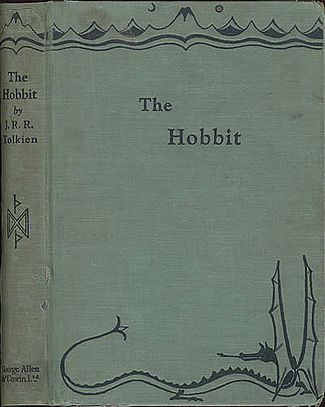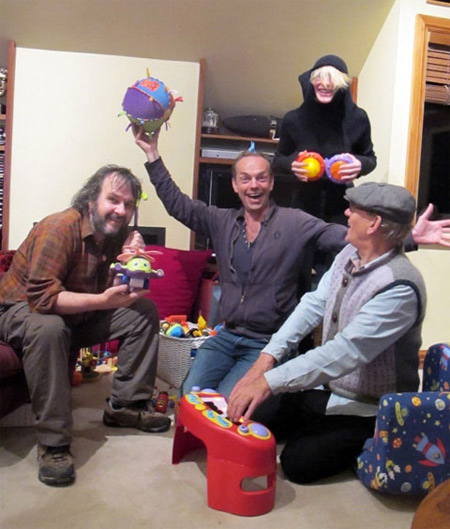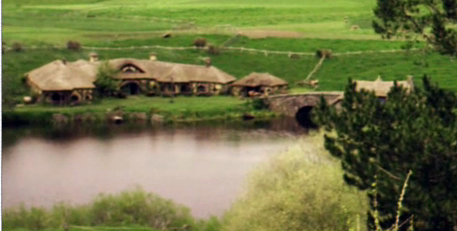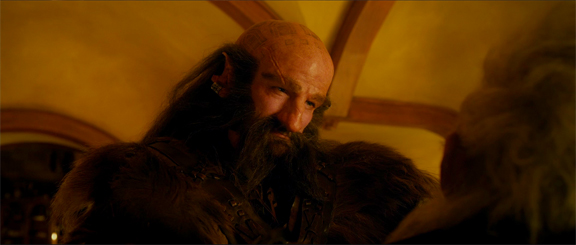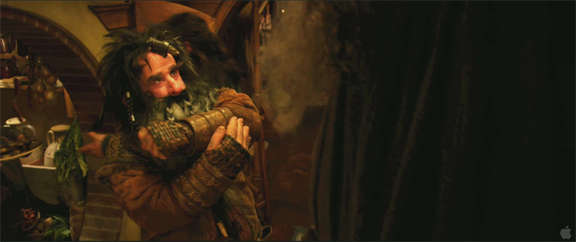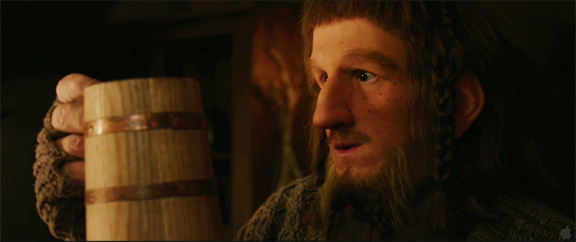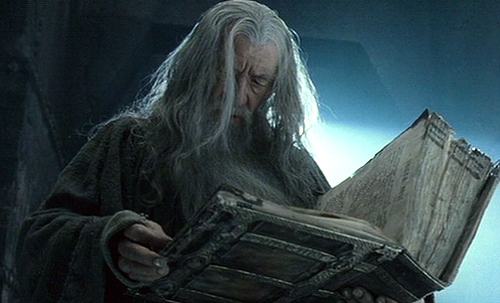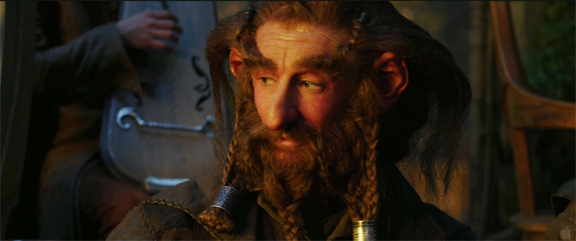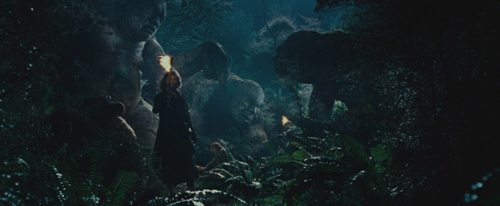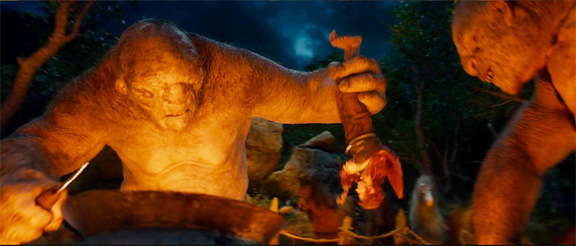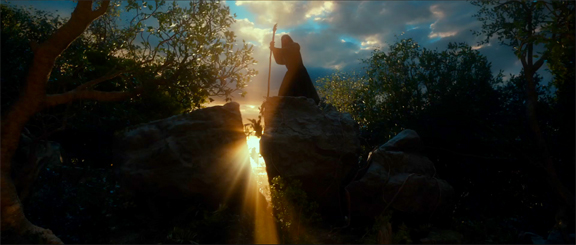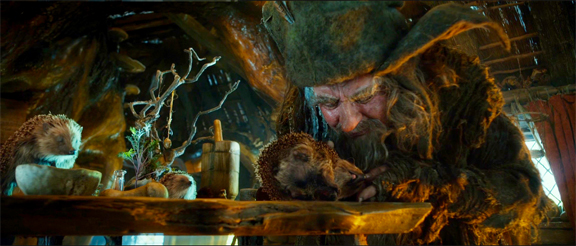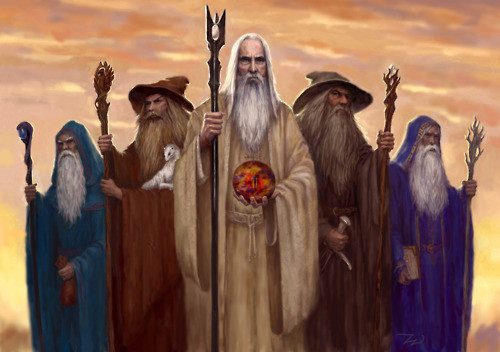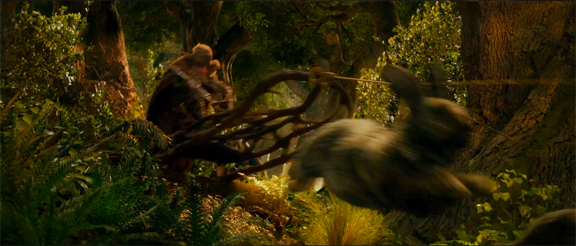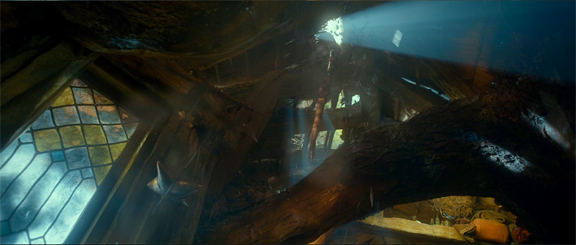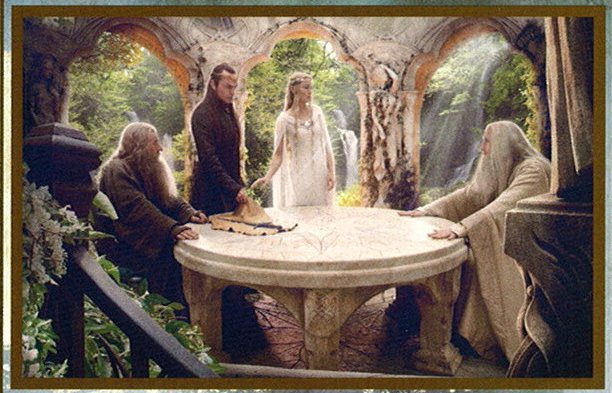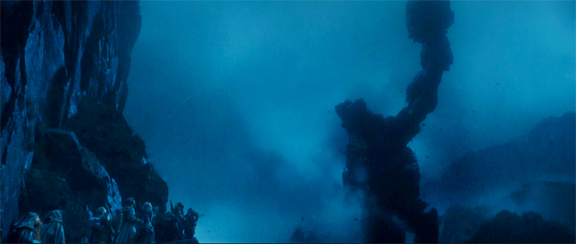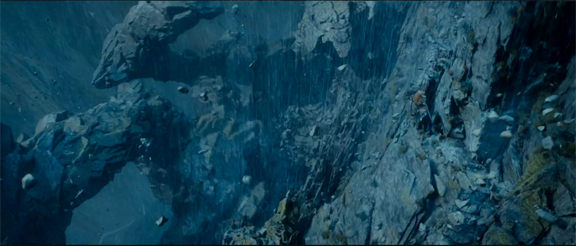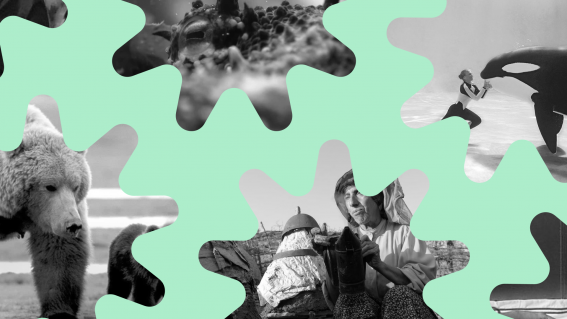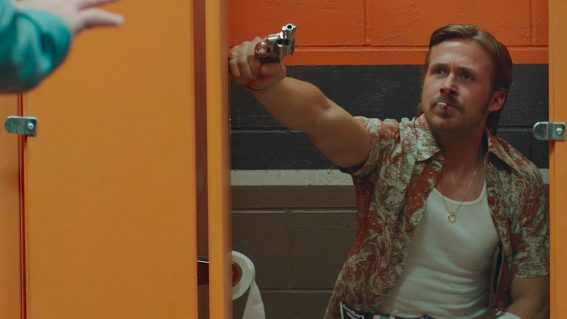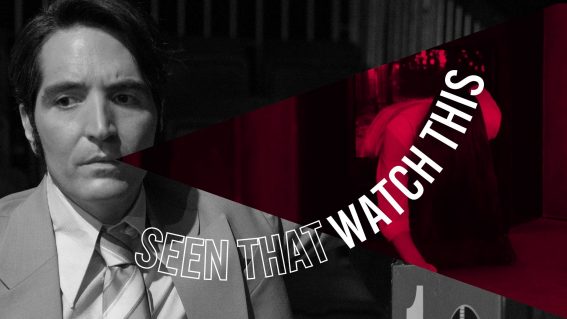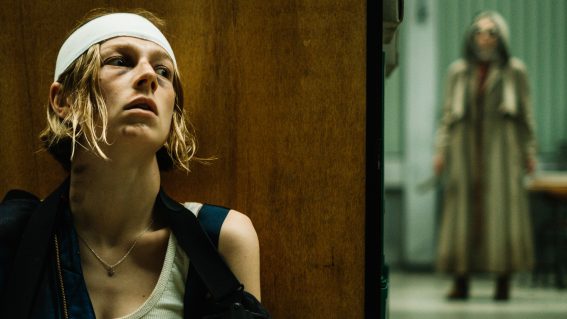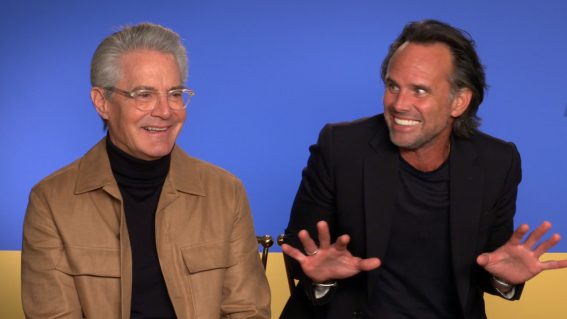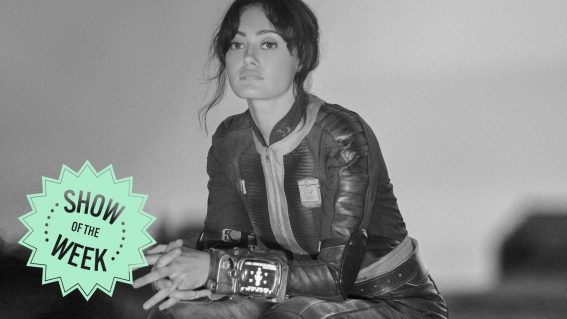Secrets Of THE HOBBIT Trailers – Part 1

I love Peter Jackson’s take on Middle Earth. While I acknowledge that not every Tolkien fan would agree with me, I think it’s just pretty terrific and is one of the best realised cinematic universes I’ve ever seen. And like many fans of the Lord Of The Rings movies, I’m looking forward to what The Hobbit trilogy will add to that universe and what Jackson and WETA’s take on that material will look like onscreen. And because we have Jackson’s filmography and a prior 12-hour trilogy of films to work from – plus all of Tolkien’s books – we can infer some interesting ideas on what is to come. To that end, I now join the rabid fanbase and present my own little dissection of the two Hobbit trailers (and some other supplementary materials).
Spoilers ahead? Duh. If you haven’t read the book(s) and you want to remain in the dark about the plot, the characters and the surprises, this is definitely not for you. If you’re a hardcore Tolkien fan, there may be a few unconsidered things revealed here, but you probably will have guessed many of these yourself. If you’re more of a moderate fan, someone who knows the story and isn’t afraid to get excited by small revelations and details (especially since we’re only really covering the first film in the trilogy) then this article is definitely for YOU.
Of course one of the major issues everyone seems to have with The Hobbit Trilogy is this notion that there is no way to make three movies out of such a ‘small’ book. Yes, though Professor Tolkien had been swimming in the imaginative pools of proto-Middle-Earth since his time in the trenches of the First World War, The Hobbit was his first really successful attempt at boiling down all of its elements into one cohesive narrative. And yes, it was a children’s book. Being a children’s book, its narrative voice was simple, its characters were broad and over-the-top (often displaying child-like logic and emotions), it was light on conversation, heavy on whimsy and magic and moved at a brisk pace at an age-appropriate language. While epic in scope, it’s no ‘Lord Of The Rings’ and even its inclusion of Gollum and the (not yet established) One Ring was originally just a plot device to grant Bilbo the power of invisibility while the Necromancer was merely an excuse to get Gandalf out of the way so that Bilbo could become a hero in his own right. How could this little 300-odd page children’s book from 1937 become an epic three-part trilogy?
Well. The first thing I always ask someone when they ask this is: “have you actually read the book recently?” Because The Hobbit actually contains enough story and plot elements to easily fill two movies.
How?
First: examine Jackson’s adaptation of The Lord Of The Rings and look at the number of sequences, scenes and conversations that were based on events either only referenced obliquely by Tolkien or were pure creations of Jackson and company e.g. Gandalf’s duel with Saruman at Orthanc, Aragorn’s rejection of Arwen at Rivendell, most of the battle sequences which Tolkien doesn’t dwell on, the Warg attack in Rohan, Aragorn’s plunge into the river, the creation of the Uruk-Hai and Lurtz their general, Haldir and the elves battling at Helm’s Deep, Gothmog and the Witchking’s interactions with their troops and so on and so forth. Clearly, whether or not you agree with it, Jackson and his fellow screenwriters Fran Walsh and Phillipa Boyens possess an ability to modify, shrink and expand Tolkien’s work for cinematic purposes to a level which means that they won’t actually ever be short on content.
Second: look at the amount of content that has to be created to mesh The Hobbit with the Lord Of The Rings films. Again, The Hobbit is a children’s book; it doesn’t contain naturalistic dialogue, its minor characters are not complex in the same way as they are in the films, a lot of the story is told by Tolkien’s narration rather than from the characters actually driving their own scenes forward and so on. It becomes necessary to grow the story for broader audience; not just fans of the book, but discerning adults and kids who expect the same tone and feel and consistent universe of The Lord Of The Rings films. This means more content, more dialogue, more character interactions, more defined motivations, a more lived-in and complex universe.
Finally: I ask people again – “Have you actually read the book recently?” The Hobbit is much longer than most people remember. Though the journey on paper seems swift from Hobbiton to Mirkwood, people forget that the film has to open with the introduction of The Shire, Bilbo Baggins and 13 other main characters, the back story of the Lonely Mountain, Smaug and Thorin’s people, Bilbo’s accepting his mission and then their subsequent departure. Then there’s the encounters with the trolls, with Elrond and the finding of the moon runes, their treacherous crossing of the Misty Mountains, their battle in Goblin Town, Bilbo’s meeting with Gollum and the theft of the Ring of Power, their pursuit by the Wargs, their encounter with Gwahir and Beorn, then their journey through Mirkwood and encounters with the spiders and Thranduil’s people and then their escape down the river… that is one action-packed movie if you don’t mind me saying so. More than that, it’s a perfect unresolved, three-act story. Then if you look at the second half of the story (yes, that’s only halfway) then you have the dwarves arrival in Lake Town and dealing with its inhabitants, their journey to Erebor, Bilbo’s descent into the mountain and riddling with Smaug, Smaug’s attack on Lake Town, the siege of Erebor, the breakdown of party over the Arkenstone, the epic Battle Of The Five Armies and then Bilbo’s return to the Shire; another perfect three act story.
That’s two films done and dusted. Even if you could squeeze all that into a 3-hour movie, you’d have to trim many sequences and characters to get your money’s worth and, at the same time, sacrifice some of the epic scope of the film. As far as I’m concern, doing the story in two parts is a no-brainer and anyone who said otherwise; I say read the book again and use your imagination.
The third film? Okay, this is a contentious area. Initially there was speculation that the third film would be set in between The Hobbit and The Lord Of The Rings; a period that is described with startling detail in the appendices of The Return Of The King. It has now been revealed that the third film will be made up of content only relating to what’s happening on Middle Earth while Bilbo and the Dwarves are adventuring towards Erebor i.e. the clash between the White Council and The Necromancer Of Mirkwood (who is revealed to be Sauron in diminished form, still rallying his strength after his defeat in the Second Age by Isildur). Given the inclusion of Saruman (witnessed in the making-of-videos), Radagast and Galadriel; it’s pretty evident that they’re attempting to lay the foundation for Sauron’s sudden return to power as seen in Fellowship Of The Ring and possibly even the corruption of Saruman. My guess is as good as anyone’s on what this is going to look like, but it seems that what we’ll be witness to is the small amount of material in the Appendices, plus large sections of back story from The Lord Of The Rings text, which will then be expanded by Jackson, Walsh and Boyens into at least a movie’s worth of content. Can it be done? I genuinely don’t know, but I’m relishing the opportunity to go swimming once again in that glorious pool that is Jackson’s version of Middle-Earth. So to doubters, I say it’s completely possible, but whether or not it will be great movie-making is left to be seen.
Back on topic: to date we’ve had a range of photos and artwork published from the upcoming film trilogy plus two delicious trailers. First was the teaser trailer, released around nine months ago:
Which introduced the idea that we were going to see what Bilbo’s often-referred to adventures in The Fellowship Of The Ring actually were about. Many elements were teased and left unexplained, beautiful New Zealand scenery was revealed and we were given a roll-call for the thirteen dwarves that invaded Bilbo’s life and carried him off on an ‘unexpected journey’. Then, about a month ago, we were treated to the more broad and dynamic first theatrical trailer:
This trailer still doesn’t tell audiences, unfamiliar with the original novel, the full grasp of the story. It establishes that the dwarves want to retake a distant mountain and they’re taking Bilbo along with them, but doesn’t tell us why. It also teases that there are greater stakes behind this mission than Gandalf is letting even Bilbo know about (Necromancer-content). Nevertheless, both trailers (and various supplemental materials) reveal a lot about what we can expect to see in the upcoming trilogy and allow us to infer a few things which may or may not turn out to be true.
A PROLOGUE?
The first question that comes to mind is whether the films will feature a prologue, in the same fashion as the Lord Of The Rings trilogy. Stylistic continuity suggests that it wouldn’t hurt; but whatever information needs to be imparted would surely only surround a vague introduction to Middle Earth, The Shire and Hobbits in general. Wouldn’t Bilbo Baggins (Martin Freeman) be a perfectly sound vehicle to deliver this information rather than an elaborate prologue? But then again, Jackson’s love for incorporating many of Tolkien’s famous lines into his films suggests a necessity that the novel’s opening sentence: “In a hole in the ground, there lived a Hobbit” should make an appearance somewhere. And where would that fit in better than spoken by Gandalf or Galadriel during a prologue (since it wouldn’t be Bilbo’s character to refer to Bag End as a ‘hole in the ground’)?
And there’s this curious image showing Bilbo going about on his day-to-day routine in some Hobbiton market. A scene that doesn’t appear to be motivated by anything in the novel; could this be from some section of the prologue describing Hobbits?
Then again, we also shouldn’t forget about the Dwarves back-story either! Would the attack on Erebor by Smaug be depicted in Thorin’s table-side recounting, or would it glimpsed in a prologue instead? Difficult to say at this stage I’m afraid, though a quick bit of research shows that Thror (Thorin’s grandfather) and Azog (the goblin who slew Thror) have been cast in the film and suggests a lot of effort will be put into creating the ‘historical context’ behind the story.
THE FRAME-STORY
Yeah, okay, I have to admit this is a little weird.
Clearly what’s being established in the first shot of the teaser is that The Hobbit Trilogy will be told in prolonged flashback. And not just any kind of flashback, but one that happens near the moment that Gandalf arrives in Hobbiton for Bilbo’s birthday at the start of The Fellowship Of The Ring. Elijah Wood appears as the happy-go-lucky Frodo, Ian Holm returns as 111-year old Bilbo and we can even see Bilbo’s ‘No admittance except on party business’ sign posted on the front-gate of Bag End. But how exactly will this frame-story work? There are numerous reasons why Jackson and Co might have decided to go this route; one maybe the simple fact that they feel it necessary to tie The Lord Of The Rings film trilogy to this one. Perhaps to appease the studio marketing? The other could be that this frame-story is part of an elaborate attempt to ensure that the two trilogies can be watched in any order: something which George Lucas famously attempted and failed with the Star Wars prequels.
Prequel-itis is the most dangerous and easily contagious disease that could ruin this trilogy of films. Learning from Lucas’ mistakes is imperative: his unwillingness to create a cohesive look in the art direction, performance, visual effects and cinematography style. His insistence on inserting jokes and cameos in the prequels that only make sense if you watch them after the Original Trilogy. He relies on audiences knowing what’s going on because of information in the earlier films rather than having the discipline to create consistent and self-supporting stories which would ensure that the two trilogies could be watched in any order. Jackson and company need to do everything that Lucas didn’t by making The Hobbit films feel as if they were indeed shot and released first, so that they’d stand up on their own story-logic without the other films to support them and that they would naturally and consistently flow into the other films.
Credit where it’s due: the film’s digital RED Epic photography certainly captures the look and feel of The Lord Of The Rings. Point for Jackson where Lucas failed. Is this frame story, set so close to the opening scene from The Fellowship Of The Ring another point in Jackson’s favour? Could it be that Bilbo decides to write his book because he recounts his story to Frodo and is then inspired to put pen to paper (since he writes the first words of that book in Fellowship Of The Ring and is then interrupted by Gandalf knocking at his door)? We’ll have to wait and see.
DETAIL OF NOTE: the bench seen in the above screenshot (and in the previous trilogy) is the very same one in which Bilbo sat sixty years earlier, smoking his pipe one fine morning when he was interrupted by Gandalf The Grey as shown here:
Also worthy of noting is the distance The Green Dragon pub (now a permanent feature, along with everything else, at the Hobbiton movie-set in Matamata) where Bilbo has to meet with the dwarves on the morning of their departure and also where, sixty years later, Frodo, Merry and Pippin will spend much of their time getting loaded and Sam will eye up the pub’s barmaid (and Sam’s future wife) Rosie Cotton.
THE DWARVES – PART 1
Right. There’s thirteen of these diminutive, hard-partying bastards so let’s take each of them in turn, starting with the book’s famous dwarf entrance into Bag End:
In the book, the dwarves appear on Bilbo’s doorstep in a staggered series of comedic arrivals that drive Bilbo crazy (in a way that kids love). The above image of several visitors tumbling into Bag End happens in the book, but actually involves far less dwarves. A quick head count and it’s plainly apparent that in the movie, Bilbo will answer the door to Dwalin (as he does in the book), then to Balin (who shares a headbutt greeting with Dwalin in the theatrical trailer) and then Fili and Kili (who arrive together). Then, if the above image is accurate, it appears that the remaining nine dwarves plus Gandalf all appear together and do the fall-through-the-door gag. Hooray, our sanity (and Bilbo’s) is spared!
Dwalin (Graham McTavish), younger brother of Balin, is the first to arrive at Bag End. Out of all of the dwarves in Thorin’s company, he ends up having the warmest disposition towards Bilbo and, in the novel, encourages and supports him on several occasions. Made one of the tallest (and seemingly toughest) dwarves in the party, WETA’s designers have given him a bald scalp tattooed with Dwarf Runes and additional tattoos all over his body.
Balin (Ken Stott) arrives second to the meeting at Bag End. Brother to Dwalin, he is the oldest dwarf in the group and offers words of sagely wisdom. Balin, of course, meets a tragic end sometime between The Hobbit and The Lord Of The Rings in the Mines Of Moria when his excursion to reclaim Khazad-Dum results in the death of himself and his entire party at the hands of goblins. Their fate remains a mystery until Gimli and the Fellowship visit Moria expecting a ‘royal welcome’ which turns out to be battle for survival against orcs, a cave-troll and a Balrog and the discovery of Balin’s tomb deep in the heart of the mines.
Bifur is traditionally part of the ‘secondary seven’ dwarves (Oin, Gloin, Bifur, Bofur, Ori, Dori, Nori) in Thorin’s Company who (in the novel) don’t stand out as much as the six primary ones (Dwalin, Balin, Fili, Kili, Bombur and Thorin). The good thing about a trilogy is that these seven dwarves will finally get the chance (we hope) to become fully developed characters of their own.
Bifur (New Zealand actor William Kercher) is a working-class, smithy dwarf who hails from the same clan as Bofur and Bombur, and is notable in ‘The Hobbit’ for having a grand total of somewhere between one to three lines of dialogue (depending on which edition of the book you read). To remedy this, Jackson digs deep from his dark sense of humor and strips him of all of his dialogue thanks to an axe-blade planted deep into his skull which has impeded his ability to speak. An interesting change of character, this allows Bifur to stand out among Thorin’s company and is very much in the spirit of the whimsical humor the Dwarves bring to Tolkien’s work.
Known to be a formidable fighter, Bifur no doubt wears his axe-blade with pride (or is possibly so brain damaged he isn’t even aware of it anymore) and communicates to his friends in Khuzdul: a secret Dwarf language made up of hand-gestures and grunts. Fans can’t wait to see what Khuzdul is for ‘raspberry jam and apple tart’ which he demands from Bilbo for his supper in the novel.
Damn I love Bofur. From the moment I saw him, I knew the Dwarves may end up being my favourite species out of everything in Jackson’s Middle-Earth. Played by the awesome James Nesbitt, everything from his prosthetics to costume to his props screams ‘thinking outside the box’ and that alone makes him fascinating to look at. Bofur is the brother of Bombur and, like his kinsman Bifur, didn’t stand out much at all in the original book. Here’s hoping there are bigger and better things in store for Bofur in the trilogy.
Ori (played by Adam Brown) is modeled as a bookish, monk-like dwarf who is brother to Dori and Nori. Little is known about Ori’s depiction in the movie as he was yet another one of the novel’s secondary dwarves, though after the events of ‘The Hobbit’ he is known to journeyed with Balin in his ill-fated mission to retake the Mines Of Moria.
Ori’s scholarly appearance is clearly a foreshadowing of his ultimate fate: he was the scribe who wrote the words ‘We cannot get out, drums, drums in the deep, we cannot get out, they are coming!’ in the book which Gandalf finds in Balin’s Tomb and reads aloud to the Fellowship. Grim and dark as it may seem, it is possible that one of the many skeletons littering the floor of that chamber belongs to poor Ori.
Dori (played by New Zealand actor Mark Hadlow) is brother of Ori and Nori and is supposed to be the most ‘Hobbit-like’ of all of the Dwarves, sharing Bilbo’s passion for comfort, food and endless complaining. This, of course, gets him into trouble with the rest of the Company on a couple of occasions in the book including a famous moment where it accidentally loses Bilbo, resulting in the hobbit’s first encounter with Gollum in the caves of the Misty Mountains.
Nori (played by New Zealand actor and Peter Jackson regular Jed Brophy) is brother of Ori and Dori and is another secondary-dwarf in the novel which meant he didn’t get the chance to contribute much to the narrative, though he’s hard to miss in this version with his bitchin’ starfish hair-do and beard. Like Bofur, Ori and Dori, we hope that the trilogy will give Nori ample time to come into his own as a character.
We will look at the remaining six dwarves in a later post…
“MR BILBO’S TROLLS”
If there’s any exclusive element from The Hobbit that survived into the Lord Of The Rings that made fans squee with delight, it was almost certainly Bert, Tom and William Huggins a.k.a “Mr Bilbo’s Trolls” as Samwise Gamgee called them as they sought refuge from the Nazgul.
Different from the cave-troll, mountain trolls and the genetically bred Olog-Hai from the original trilogy of films, these characters are known as ‘stone trolls’ in Tolkien canon and differ from regular trolls due to their ability to speak (at least in the books anyways) and the curious fact that exposure to sunlight will permanently turn them into stone (ironic, right?).
The story of how they were tricked into being turned to stone is partially recounted by Bilbo to the young hobbit children during his birthday party in the Fellowship Of The Ring, but at last in the first film of The Hobbit trilogy we will get to see exactly how it all went down.
Revealed in both the teaser and the theatrical trailers, Bilbo and the Dwarves unfortunate encounter with the trio of terrible trolls seems to very much fit the novel. However there are still many questions left unanswered at this stage; will the trolls actually talk? Will they actually be called Tom, Bert and William Huggins; since Tolkien later retconned their names as “equivalents” rather than actual names. And, most curiously, the trolls in the trailer don’t resemble much of the life-size statues of the trio that appeared in Comic-Con earlier this year.
Of course this leads us to question whether the Comic-Con statues were based on the original Del Toro version of the film; given that the trolls in the trailers do resemble the stone statues in The Fellowship Of The Ring movie? Or, perhaps more likely, the trolls in the trailer represent earlier, unfinished versions which will be refined (as was many of the original film trilogy’s effects compared to how they appeared in their trailers)? This low angle of the dwarves attacking the trolls in an effort to free Bilbo certainly suggests that their costumes match that of the Comic-Con trolls in any case.
The other question is their transformation into stone. ‘The Hobbit’ is far more free with fairy-tale style magic and bizarre creatures, due to its origins as a children’s book, than is say ‘The Lord Of The Rings’ which takes pains to separate magic and science to a degree. One of the most contentious issues from the book was Gandalf’s role in how the trolls are transformed and whether he merely kept them busy and arguing until the sun came up, or whether he played some greater role in their destruction. The trailer shows an interesting compromise…
In the film, it seems that the trolls had hidden their campsite beneath the shadow of a great rock which allowed them to flee back to their caves as the sun rose on the horizon without fear of being turned into stone. Gandalf is seen shearing away this rock with his magic staff, thereby causing the sunlight to burst through and catch the unwary trolls off-guard. All in all, I think this is a good interpretation of the sequence and certainly raises Gandalf’s power and value for the viewer if they were watching The Hobbit trilogy before The Lord Of The Rings.
Naturally, of course, the next sequence almost certainly be where the Dwarves raid the trolls nest and find a slew of treasures.
Among their finds will be the Elven swords Glamdring (which becomes Gandalf’s sword for all six films), Orcrist (Thorin’s sword) and an enchanted elven dagger (sword-size for a hobbit) that Bilbo claims and later names ‘Sting’. At the end of his adventures, Bilbo eventually passes Sting onto Frodo and Sam will eventually use it to fight Shelob and Gollum.
RADAGAST THE BROWN
One of the biggest head-scratchers for the new trilogy is the Jackson camp’s decision to include the wizard Radagast (aka ‘The Brown’).
Known to specialize in the world of birds and animals, Radagast (played by Sylvester McCoy, an ex-Doctor Who) is a character only mentioned in a passing line of dialogue in ‘The Lord Of The Rings’ and whose role in the greater events of Middle Earth is one of much speculation since Tolkien didn’t leave us with much to go off.He is one of the five Istari (Wizards) who were sent to Middle-Earth by the Valar (consider them as a pantheon of Gods) to aid the Free Peoples Of Middle-Earth to combat evil after the destruction of Sauron in the Second Age by Isildur.
The five wizards were Saruman The White, Gandalf The Grey, Radagast The Brown and two ‘Blue Wizards’ named either Alatar & Pallando or Morinehtar & Rómestámo (Tolkien sadly never clarified their characters before his death). The Blue Wizards famously ventured into the East, far past Mordor, and were never heard from again (though some of Tolkien’s work speculates they were busy being a monkey-wrench in Sauron’s influence in the East). Saruman, Gandalf and Radagast remained to form The White Council with Elrond, Galadriel and Cirdan The Shipwright (who appears as a background extra in the Grey Havens at the finale of The Return Of The King) in an effort to keep evil at bay, find the One Ring and destroy Sauron forever.
Radagast’s inclusion in The Hobbit is clearly another indicator of how the film will focus on the White Council subplot hinted in the appendices of ‘The Lord Of The Rings’ where they uncover the Necromancer of Mirkwood to be none other than Sauron and their battle to drive him from out of his fortress known as Dol Guldur. He is thought to be absent-minded and a bit dim-witted by Saruman while others acknowledge that his express disinterest in the affairs of men and the civilized world made him an ineffective ally. Gandalf, however, always had faith in Radagast and supported him where others criticized.
Apart from his ability to communicate with all manner of species, some Tolkien lore suggests that Radagast is a shape-shifter. His absence in ‘The Lord Of The Rings’ books and film trilogy is notable; Saruman dismisses him as a wizard who has shirked his responsibilities and chosen to care only about animals. Some speculate that Radagast’s absence will be addressed in The Hobbit trilogy and many have suggested that the white moth that summons the Great Eagles in The Fellowship Of The Ring and The Return Of The King is either an emissary of Radagast’s…or perhaps the wizard himself in animal form. While I personally subscribe to this theory, officially Radagast’s ultimate fate is never revealed by Tolkien.
Like Saruman in Orthanc, Radagast based himself in Rhosgobel: a wizard’s lair built inside a tree-trunk on the western edges of the forest of Mirkwood. Featured in the trailer is a shot of what appears to be a giant Mirkwood spider invading his home through the roof which correlates with the Necromancer’s growing power over of the forest which sees a steep rise in dark creatures and evil magic throughout the region. Perhaps it was only a matter of time before they came after Radagast, forcing him to flee his home.
RIVENDELL
Rivendell of course makes an appearance in ‘The Hobbit’. And for the film trilogy, it should pay well to avoid ‘prequel-itis’ by ensuring that Jackson treats this as the first time we see Rivendell and meet its master: Elrond The Half-Elven.
Like the journey of the One Ring, the famous house serves as a launch platform for the Dwarves in their bid to reclaim Erebor. Beyond that, the place also serves as one of the meeting places of The White Council.
The Hobbit Trilogy offers us a unique glimpse – possibly – of seeing Rivendell in its full glory given that by the time of The Lord Of The Rings the place is being emptied as the Elves begin to migrate back to the Undying Lands. Seeing Galadriel present in Rivendell in the trailers was, of course, a shock for many fans who never really considered that she would travel there.
Rivendell is also where Elrond aids the Dwarves in getting their bearings in a number of ways including deciphering the ancient elvish ruins on their weapons (recovered from Tom, Bert and Bill’s lair) to reveal them as famous swords of ancient Elvish make. A portion of this sequence can be seen as one of the multitude of alternate-tails to the theatrical trailer as seen here:
In addition, Elrond also aids the Dwarves in deciphering the enigmatic map of the Lonely Mountain which c0ntains Dwarvish Moon Runes which appear on the map only during certain lunar phases. This is reminiscent, of course, of the hidden door to the Mines Of Moria which are only visible in certain phases of starlight and moonlight and suggests a wonderful follow-through of Dwarvish technology.
The large crystal pictured above is suggested by many fans to be a kind of primitive light-table which refracts moonlight upwards and allows the moon runes to be seen on the map (which we can see Elrond clearly holding in his hand).
THE STONE GIANTS
After leaving Rivendell, Thorin’s Company has their first major encounter with some of the more terrifying creatures of Middle Earth in the form of Stone Giants. What exactly these are, according to Tolkien’s original novel, is left to the imagination though they are known for throwing gigantic boulders back and forth across the mountaintops for fun (and to the terror of the dwarves).
Peter Jackson and the WETA crew have decided to take the Professor at his word for their cinematic incarnations, which show that the Stone Giants are in fact gigantic creatures made out of rock and who most certainly live up to their namesake. Although they are mentioned in passing in the original text, it does appear (judging from the trailer footage) that we can expect a protracted action sequence surrounding these magical creatures and the danger they pose, as the final shot of the trailer reveals:
This brings us to the end of Part 1 of our Hobbit trailer dissection. Tune in for Part 2 where we uncover more trivia behind the dwarves, the big baddies of the first film and the Necromancer! Coming soon!
Thanks for reading!

